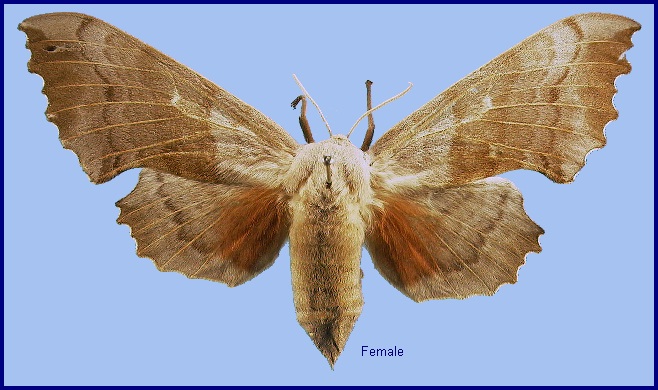
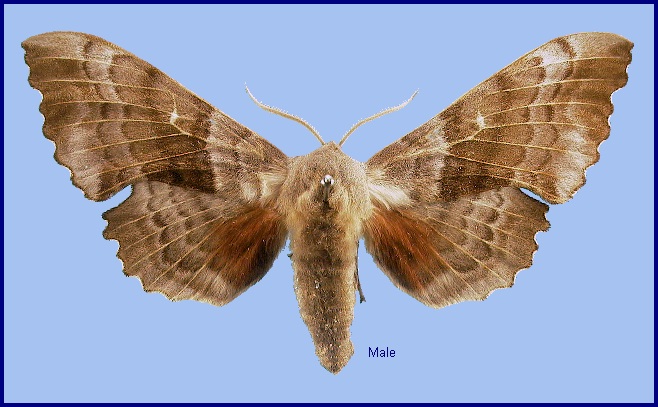
Sphinx populi Linnaeus, 1758, Syst. Nat. (Edn 10) 1: 489. Type locality: not stated [Sweden, Stockholm].
Synonym. Sphinx tremulae Borkhausen, 1793
Synonym. Smerinthus populi rufescens de Selys-Longschamps, 1857
Synonym. Merinthus palustris Holle, 1865
Synonym. Merinthus populi salicis Holle, 1865
Synonym. Smerinthus populi rufescens Fuchs, 1889
Synonym. Smerinthus borkhauseni Bartel, 1900
Synonym. Smerinthus populi fuchsi Bartel, 1900
Synonym. Laothoe populi pallida Newnham, 1900
Synonym. Smerinthus populi violacea Newnham, 1900
Synonym. Amorpha populi pallida Tutt, 1902
Synonym. Amorpha populi suffusa Tutt, 1902
Synonym. Smerinthus populi decorata Schultz, 1903
Synonym. Smerinthus populi cinerea-diluta Gillmer, 1904
Synonym. Smerinthus populi ferruginea-fasciata Gillmer, 1904
Synonym. Smerinthus populi ferruginea Gillmer, 1904
Synonym. Smerinthus populi grisea-diluta Gillmer, 1904
Synonym. Smerinthus populi grisea Gillmer, 1904
Synonym. Smerinthus populi pallida-fasciata Gillmer, 1904
Synonym. Smerinthus populi rufa-diluta Gillmer, 1904
Synonym. Smerinthus populi rufa Gillmer, 1904
Synonym. Smerinthus populi subflava Gillmer, 1904
Synonym. Smerinthus populi rectilineata Klemensiewicz, 1912
Synonym. Amorpha populi angustata Closs, 1916
Synonym. Amorpha populi philiponi Huard, 1928
Synonym. Amorpha populi flavomaculata Mezger, 1928
Synonym. Amorpha populi lappona Rangnow, 1935
Synonym. Amorpha populi depupillatus Silbernagel, 1943
Synonym. Laothoe populi albida Cockayne, 1953
Synonym. Laothoe populi basilutescens Cockayne, 1953
Synonym. Laothoe populi moesta Cockayne, 1953
Synonym. Laothoe populi bicolor Lempke, 1959
Synonym. Laothoe populi minor Vilarrubia, 1973
Synonym. Laothoe populi iberica Eitschberger, Danner & Surholt, 1989
Wingspan: 70--100mm. A very distinct species with rust-red hindwing patches, confusable only with Laothoe amurensis (Staudinger, 1892). Ground colour of the wings varies considerably from pale buff, through pale browns, reds (mainly in females), and greys to an almost black suffusion. Likewise, the transverse lines can be either very prominent, or totally absent, while the hindwing patches may be any shade of red or brown, and any size. Gynandromorphs are common, and if each half is a different colour, the effect can be striking. Developing pupae subjected to heat produce pale buff to rose-red adults. Cold conditions can produce adults which are dark grey.
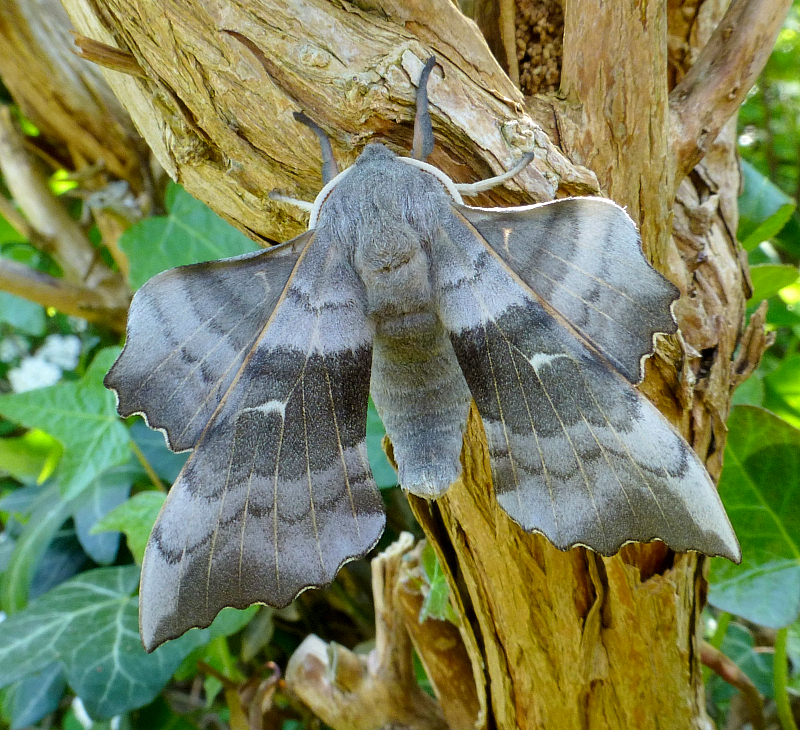
China: Unknown in China but presumably late May to late July, as in adjacent areas of Altayskiy Krai, Russia. The main flight period in Siberia is mid June to mid July. Four specimens have been captured in Buryatia, on the 14.vii.1987 (1) and 14-15.vii.1996 (3) (Vladimir Dubatolov, pers. comm. 2012).
OVUM: Pale green, almost sperical and large for the size of moth.
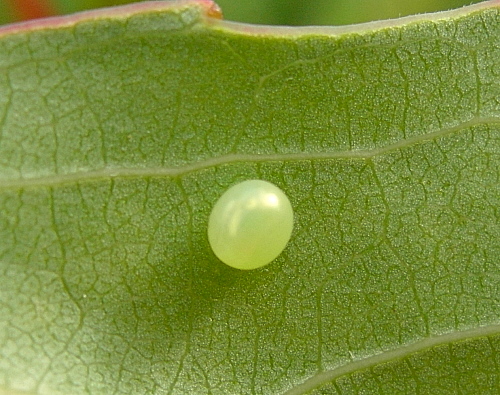
LARVA: Typically sphingiform; very similar to that of Smerinthus ocellata (Linnaeus, 1758), but body stouter and horn smaller.
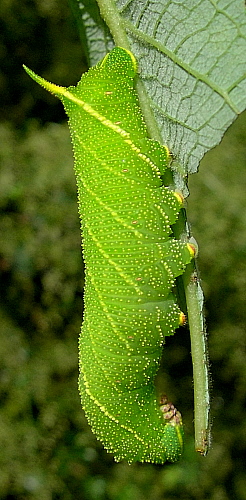
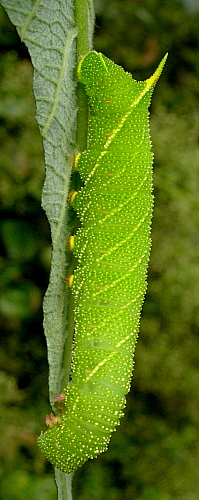
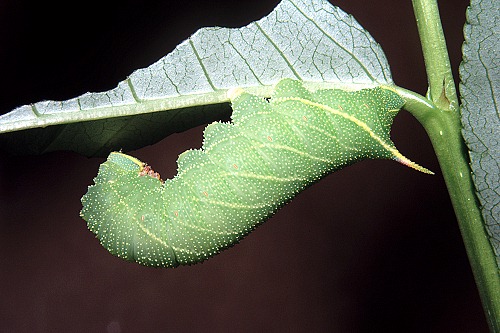
PUPA: Matt black or dark brown, rough (not glossy), unlike that of Smerinthus. Cremaster short, dorso-ventrally flattened, broad at base and terminating in a sharp point.
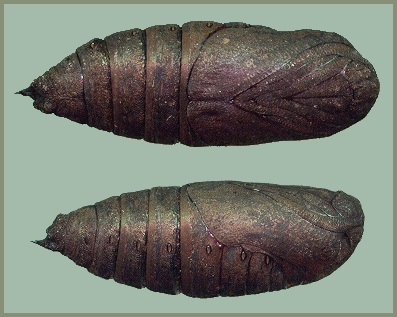
Larval hostplants. Unknown in China but oligophagous in Europe on Populus and Salix, with occasional records on other trees (Pittaway, 1993). These are the same hosts at Novosibirsk, Russia (V. Dubatolov, pers. comm. 2010).
Unknown for the region.
China: Xinjiang (Tacheng).
[Danner et al. (1998) noted a single male, from Taibai Shan, Shaanxi (collected by H. Höne in 1936), that had genitalia matching those of Laothoe populi populi. As this record is well outside the known distribution of Laothoe populi, we initially considered it represented a relict population rather than a labelling error. Subsequently, Saldaitis, Ivinskis & Borth (2010) found sufficient differences in male genitalia and barcode of the cytochrome oxidase subunit 5' region to consider this isolated population to be a good species, namely Laothoe habeli Saldaitis, Ivinskis & Borth, 2010.]
An individual recorded from southeast of Turpan, Xinjiang, on 14.vi.2019 appears to be Laothoe populi populetorum (Staudinger, 1887) (Skulltronix, iNaturalist 2019).
Russia: Altai (Krasnoshchekovo; Barnaul; Borovlyanka; Klyuchi; Aleysk); Siberia (Tomsk; Krasnoyarsk; Alaevo; Karasuk; Bolotnoe; Kayly; Novosibirsk, Alchedat; Irkutsk; Kolomino; Porotnikova; Asino; Bazoy; Kupino; Novodubrovka; Kaninovka; Chingisy); Buryatia (Kultuny; Monakhovo; Dobo-Yonkhor).
Recorded by Pittaway (1993) throughout Europe (with the exception of the far north and parts of the Iberian and Balkan Peninsulas), east as far as southern Turkey, and across Russia to just east of the Urals. Now known to extend much further east across Russia (north of the Kyrgyz Steppe), as far east as Irkutsk (E. Berlov, pers. comm.) and the Barguzin/Ulan-Burgasy Mountains (Transbaikalia, east bank of Lake Baikal) (V. Dubatolov, pers. comm. 2010; Gordeev & Gordeeva, 2021). It was considered common in 2012-2019 at Reka Khara-Atsagat (Gordeev & Gordeeva, 2017). From here it extands south to the extreme northwest of China in Xinjiang (Pittaway & Kitching, 2000). In this part of its range, the Dzungarian Gate/Gap and the inhospitable deserts to either side appear to separate the more northern Laothoe populi populi from the more southern Laothoe populi populetorum (Staudinger, 1887), although this narrow barrier may now be breaking down due to the extensive planting of poplar trees. Three other species have reached the Yining/Gulja area by exploiting planted trees, namely Smerinthus ocellata, Smerinthus planus and Callambulyx tatarinovii tatarinovii (Pittaway & Kitching, 2000).
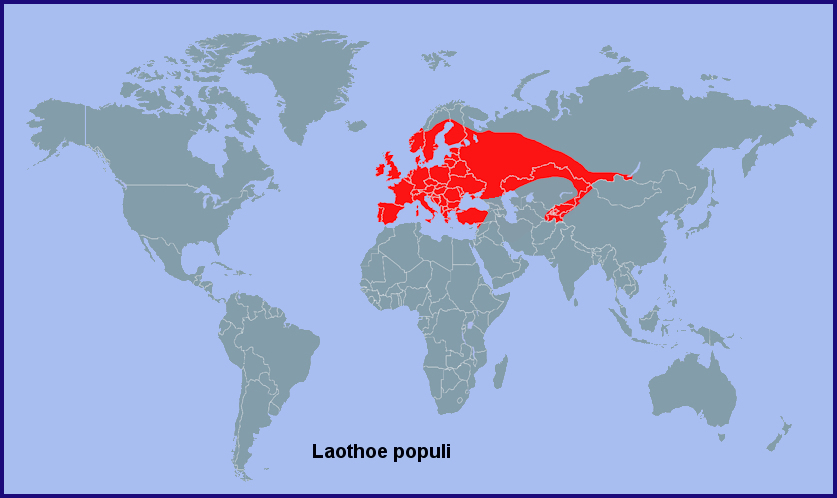
Holarctic; western Palaearctic region. Pleistocene refuge: Monocentric -- Pontomediterranean refuge.
 Return to Sphingidae of the Eastern Palaearctic species list
Return to Sphingidae of the Eastern Palaearctic species list